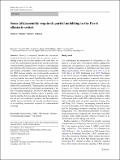Some (dis)assembly required: partial unfolding in the Par-6 allosteric switch
Author(s)
Volkman, Brian F.; Whitney, Dustin S
Download12551_2015_Article_164.pdf (702.7Kb)
PUBLISHER_POLICY
Publisher Policy
Article is made available in accordance with the publisher's policy and may be subject to US copyright law. Please refer to the publisher's site for terms of use.
Terms of use
Metadata
Show full item recordAbstract
Allostery is commonly described as a functional connection between two distant sites in a protein, where a binding event at one site alters affinity at the other. Here, we review the conformational dynamics that encode an allosteric switch in the PDZ domain of Par-6, which is a scaffold protein that organizes other proteins into a complex required to initiate and maintain cell polarity. NMR measurements revealed that the PDZ domain samples an evolutionarily conserved unfolding intermediate allowing rearrangement of two adjacent loop residues that control ligand binding affinity. Cdc42 binding to Par-6 creates a novel interface between the PDZ domain and the adjoining CRIB motif that stabilizes the high-affinity PDZ conformation. Thermodynamic and kinetic studies suggest that partial PDZ unfolding is an integral part of the Par-6 switching mechanism. The Par-6 CRIB-PDZ module illustrates two important structural aspects of protein evolution: the interface between adjacent domains in the same protein can give rise to allosteric regulation, and thermodynamic stability may be sacrificed to increase the sampling frequency of an unfolding intermediate required for conformational switching.
Date issued
2015-02Department
Massachusetts Institute of Technology. Department of BiologyJournal
Biophysical Reviews
Publisher
Springer Berlin Heidelberg
Citation
Whitney, Dustin S., and Brian F. Volkman. “Some (dis)assembly Required: Partial Unfolding in the Par-6 Allosteric Switch.” Biophysical Reviews 7, no. 2 (February 7, 2015): 183–190.
Version: Author's final manuscript
ISSN
1867-2450
1867-2469